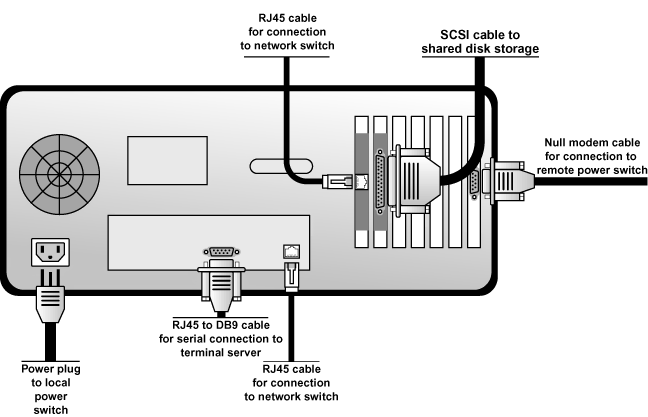2.2. Setting Up the Members
After identifying the cluster hardware components described in Section 2.1 Choosing a Hardware Configuration, set up the basic cluster hardware and connect the members to the optional console switch and network switch or hub. Follow these steps:
In all members, install the required network adapters and host bus adapters. Refer to Section 2.2.1 Installing the Basic Cluster Hardware for more information about performing this task.
Set up the optional console switch and connect it to each member. Refer to Section 2.2.2 Setting Up a Console Switch for more information about performing this task.
If a console switch is not used, then connect each member to a console terminal.
Set up the optional network switch or hub and use conventional network cables to connect it to the members and the terminal server (if applicable). Refer to Section 2.2.3 Setting Up a Network Switch or Hub for more information about performing this task.
If a network switch or hub is not used, then conventional network cables should be used to connect each member and the terminal server (if applicable) to a network.
After performing the previous tasks, install Red Hat Enterprise Linux as described in Section 2.3 Installing and Configuring Red Hat Enterprise Linux.
2.2.1. Installing the Basic Cluster Hardware
Members must provide the CPU processing power and memory required by applications.
In addition, members must be able to accommodate the SCSI or Fibre Channel adapters, network interfaces, and serial ports that the hardware configuration requires. Systems have a limited number of pre-installed serial and network ports and PCI expansion slots. Table 2-12 helps determine how much capacity the member systems employed require.
| Cluster Hardware Component | Serial Ports | Network Slots | PCI Slots |
|---|---|---|---|
| SCSI or Fibre Channel adapter to shared disk storage | One for each bus adapter | ||
| Network connection for client access and Ethernet heartbeat pings | One for each network connection | ||
| Point-to-point Ethernet connection for 2-node clusters (optional) | One for each connection | ||
| Terminal server connection (optional) | One |
Table 2-12. Installing the Basic Cluster Hardware
Most systems come with at least one serial port. If a system has graphics display capability, it is possible to use the serial console port for a power switch connection. To expand your serial port capacity, use multi-port serial PCI cards. For multiple-member clusters, use a network power switch.
Also, ensure that local system disks are not on the same SCSI bus as the shared disks. For example, use two-channel SCSI adapters, such as the Adaptec 39160-series cards, and put the internal devices on one channel and the shared disks on the other channel. Using multiple SCSI cards is also possible.
Refer to the system documentation supplied by the vendor for detailed installation information. Refer to Appendix D Supplementary Hardware Information for hardware-specific information about using host bus adapters in a cluster.
Figure 2-2 shows the bulkhead of a sample member and the external cable connections for a typical cluster configuration.
2.2.2. Setting Up a Console Switch
Although a console switch is not required for cluster operation, it can be used to facilitate member management and eliminate the need for separate monitors, mouses, and keyboards for each cluster member. There are several types of console switches.
For example, a terminal server enables connection to serial consoles and management of many members from a remote location. For a low-cost alternative, use a KVM (keyboard, video, and mouse) switch, which enables multiple members to share one keyboard, monitor, and mouse. A KVM switch is suitable for configurations in which GUI access to perform system management tasks is preferred.
Set up the console switch according to the documentation provided by the vendor.
After the console switch has been set up, connect it to each cluster member. The cables used depend on the type of console switch. For example, a Cyclades terminal server uses RJ45 to DB9 crossover cables to connect a serial port on each member to the terminal server.
2.2.3. Setting Up a Network Switch or Hub
A network switch or hub, although not required for operating a two-node cluster, can be used to facilitate cluster and client system network operations. Clusters of more than two members require a switch or hub.
Set up a network switch or hub according to the documentation provided by the vendor.
After setting up the network switch or hub, connect it to each member by using conventional network cables. A terminal server, if used, is connected to the network switch or hub through a network cable.
